NLP is a difficult challenge, as it demands the intimate interaction of many different
techniques - lexing, collocations, parsing, semantics, structure building - all using the
same knowledge representation (obviously what humans do), and all happening together.
These processes cannot function effectively in isolation, so a technology that can span
and represent them all is necessary. The following material shows how Active
Structure can achieve that. The crucial difference between this approach and all others is
that here the structure is "soft" enough (and visible enough)
to be modified by what it reads - the structure is actualised, not an algorithm or a rule.

- Changing
Technical Writing from a Craft to a Science
- Tools to support meaning in the development of text
- Hypothesising
- The use of hypothesising to avoid an explosion in grammatical patterns.
- Large parsing model
- Text of model used to analyse legal documents
- Extension to Active
Structure to Handle Free Text
- How much needed to be changed
- Mathematics of the Law
- Reading legal text and creating a valid logical/mathematical structure
- Contract Driven Enterprises
- Turning contract documents into active knowledge
- Contract Clause Example
- Converting a clause into Active Structure
- General Legal
- Beginning of representation of legislation
- Outlining
- Looking further afield, over the heads of adjacent symbols
- Above the Fray
- Eliminating ambiguity using constraint reasoning as the final step
- PipeLine to Failure in
BioInformatics
- What is wrong with pipelining
- Relation Structures
- Structures build into patterns.
- Embedded Lists
- Handling list structures embedded in a sentence using indirection.
- Dynamic Insertion
- Inserting symbols in the parse chain that are implied by their surroundings.
- Active Structure Grammar
- The difference between a static view of grammar as an end in itself, and active
structure grammar as a system component with intermingling of many simultaneous
operations, including changing the grammatical structure
- Active Structure in Law
- Applying active structure to the representation of legal text.
- Building Structure
- Shows how structures built from words are manipulated to reveal the sentence structure.
- Constraint
Reasoning in Parsing
- Dynamic building and solving of a constraint problem as a means of NLP.
- Cutting and Healing
- Putting the pieces back together in a more meaningful way after cutting them apart.
- Prepositional Chains
- Chains as a way that dense scientific or legal text builds a microcontext.
- Searching
- Searching structures transformed from text using search structures transformed from
search text.
- Wordgroups
- A powerful way of avoiding parsing
Presentations
Network Components
Some operators for handling free text:
NLP Specific Operators
Shells
Some operators for handling the structures that free text builds:
Hierarchy Specific
Operators
Related Areas
Graphical
Structure Building Tools
Orion KM
- Searching an Active Ontology
- Using Active Structure as a dynamic ontology, and then searching through it for
information

The diagram is modelled after the Jacquard loom, and attempts to show how a structure
can read words and build structure, which becomes part of the structure used to read more
words.


